Experimental and Numerical Analysis of a Temporary Bridge Connector Consisting of an Upper Bearing Block–Lower Pin Configuration
Abstract
:1. Introduction
2. Concept of the speedBridge
3. Experimental Program
3.1. Design Procedure
- Pin plates
- 2.
- Pin
3.2. Material Properties
3.3. Test Specimen
3.4. Test Setup
4. Test Results and Discussion
4.1. Overall Behavior
4.2. Strain Measurement
4.3. FE Analysis
5. Summary and Conclusions
- (1)
- The speedBridge demonstrated the ability to achieve a plastic rotation of 5% rad without fracture. The test specimen exhibited initial stiffness consistent with elementary beam theory for a simply supported beam. Notably, the maximum load reached approximately 1600 kN, corresponding to 110% of the plastic moment of the beam. Following the attainment of the ultimate load, the load-carrying capacity diminished near a displacement of 225 mm because of lateral torsional buckling in the girder.
- (2)
- Compared with a single-segment girder, the entire girder exhibited stiffer initial load–displacement behavior and demonstrated more stable ductile behavior until succumbing to lateral torsional buckling failure under the ultimate load. Additionally, the ultimate load, at 1600 kN, surpassed the plastic moment of the girder, indicating an over-strength of approximately 10% or greater.
- (3)
- The failure modes of the specimen were primarily observed as yielding in the beam section. It was concluded that the pin plates, upper pins, and lower pins possess adequate strength and stiffness until the beam section reaches a fully plastic range. Local buckling was observed on the top flange, while global buckling occurred on the outer side of the connection part. However, these instances of local and global buckling had a negligible impact on the structural capacities of the speedBridge. No plastic deformation occurred around the connection pin or connector parts, and the connecting pin remained undamaged.
- (4)
- Finite element analysis was conducted to comprehend the load transfer path, and the results demonstrated that the hinge connection exhibited sufficient stiffness and strength exceeding the bending capacity of the beam under tension without any signs of the failure modes considered during the design procedure.
Author Contributions
Funding
Institutional Review Board Statement
Informed Consent Statement
Data Availability Statement
Acknowledgments
Conflicts of Interest
References
- Viscomi, B.V.; Michalerya, W.D.; Lu, L.W. Automated construction in the ATLSS integrated building systems. Autom. Constr. 1994, 3, 35–43. [Google Scholar] [CrossRef]
- Ario, I.; Nakazawa, M.; Tanaka, Y.; Tanikura, I.; Ono, S. Development of a prototype deployable bridge based on origami skill. Autom. Constr. 2013, 32, 104–111. [Google Scholar] [CrossRef]
- Lederman, G.; You, Z.; Glišić, B. A novel deployable tied arch bridge. Eng. Struct. 2014, 70, 1–10. [Google Scholar] [CrossRef]
- Yeh, F.Y.; Chang, K.C.; Sung, Y.C.; Hung, H.H.; Chou, C.C. A novel composite bridge for emergency disaster relief: Concept and verification. Compos. Struct. 2015, 127, 199–210. [Google Scholar] [CrossRef]
- Yang, Y.Y.; Chang, C.M.; Kang, S.C.; Yeh, F.Y. Study of Construction-Oriented Structural Connectors for a Temporary Bridge. In Proceedings of the 36th International Symposium on Automation and Robotics in Construction (ISARC 2019), Banff, AB, Canada, 21–24 May 2019; Volume 36, pp. 1171–1175. [Google Scholar]
- Bijlaard, F.S.K.; Brekelmans, J.W.P.M. Joint Design for Economy and Verification Based on Eurocode 3. In Proceedings of the Sixth International Workshop. Presented at the Connections in Steel Structures VI, Chicago, IL, USA, 23–25 June 2008; pp. 7–17. [Google Scholar]
- Bijlaard, F.S.K.; Brekelmans, J.W.P.M. Plug and play type joints in steel and steel–concrete composite constructions: Development guide and design considerations. IES J. Part A Civ. Struct. Eng. 2008, 1, 237–256. [Google Scholar] [CrossRef]
- Bijlaard, F.S.K.; Coelho, A.M.G.; Magalhães, V.J.D.A. Innovative joints in steel construction. Steel Constr. 2009, 2, 243–247. [Google Scholar] [CrossRef]
- Brekelmans, J.W.P.M.; Bijlaard, F.S.K. Design requirements for plug and play type joints in mixed and steel-concrete composite construction. In Proceedings of the Proc 4th International Workshop Connections in Steel Structrures IV, Roanoke, VA, USA, 22–25 October 2000; pp. 63–70. [Google Scholar]
- Evers, H.; Maatje, I.F. Cost Based Engineering and Production of Steel Constructions. In Proceedings of the Fourth International Workshop. Presented at the Connections in Steel Structures IV: Behavior, Strength and Design, Roanoke, VA, USA, 22–25 October 2000; pp. 14–22. [Google Scholar]
- El-Sisi, A.E.D.; Sallam, H.E.D.; Salim, H.A.; El-Husseiny, O.M. Structural behavior of hybrid CFRP/steel bolted staggered joints. Constr. Build. Mater. 2018, 190, 1192–1207. [Google Scholar] [CrossRef]
- Atta, M.; Abd-Elhady, A.A.; Abu-Sinna, A.; Sallam, H.E.M. Prediction of failure stages for double lap joints using finite element analysis and artificial neural networks. Eng. Fail. Anal. 2019, 97, 242–257. [Google Scholar] [CrossRef]
- Hosseini, S.M.; Rahnavard, R. Numerical study of steel rigid collar connection affecting cyclic loading. Eng. Struct. 2020, 208, 110314. [Google Scholar] [CrossRef]
- El-Sisi, A.E.D.A.; El-Husseiny, O.M.; Matar, E.B.; Sallam, H.E.D.M.; Salim, H.A. Field-testing and numerical simulation of vantage steel bridge. J. Civ. Struct. Health Monit. 2020, 10, 443–456. [Google Scholar] [CrossRef]
- Sallam, H.E.M.; El-Sisi, A.E.A.; Matar, E.B.; El-Hussieny, O.M. Effect of clamping force and friction coefficient on stress intensity factor of cracked lapped joints. Eng. Fail. Anal. 2011, 18, 1550–1558. [Google Scholar] [CrossRef]
- Rezaeian, A.; Jamal-Omidi, M.; Shahidi, F. Seismic behavior of ConXL rigid connection in box-columns not filled with concrete. J. Constr. Steel Res. 2014, 97, 79–104. [Google Scholar] [CrossRef]
- Rahnavard, R.; Thomas, R.J. Numerical evaluation of the effects of fire on steel connections; Part 1: Simulation techniques. Case Stud. Therm. Eng. 2018, 12, 445–453. [Google Scholar] [CrossRef]
- Williamson, S.J.; Gorst, N.J.S. Friction in Temporary Works; HSE Books: Norwich, UK, 2013. [Google Scholar]
- Yang, C.; Yang, J.F.; Su, M.Z.; Liu, C.Z. Numerical study on seismic behaviours of ConXL biaxial moment connection. J. Constr. Steel Res. 2016, 121, 185–201. [Google Scholar] [CrossRef]
- Gumpertz, S. ConXtech-XL Collar Connection Model; Simpson Gumpertz & Heger Inc.: Waltham, MA, USA, 2007. [Google Scholar]
- KDS 14 31 60; Seismic Design of Steel Structures. Ministry of Land, Infrastructure and Transport: Sejong, Republic of Korea, 2022.
- AISC. Specifications for Structural Steel Buildings (360-16); AISC: Chicago, IL, USA, 2016. [Google Scholar]
- KDS 14 31 10; Design of Steel Structures. Ministry of Land, Infrastructure and Transport: Sejong, Republic of Korea, 2019.
- Smith, M. ABAQUS/Standard User’s Manual, Version 6.9; Simulia: Johnston, RI, USA, 2009. [Google Scholar]
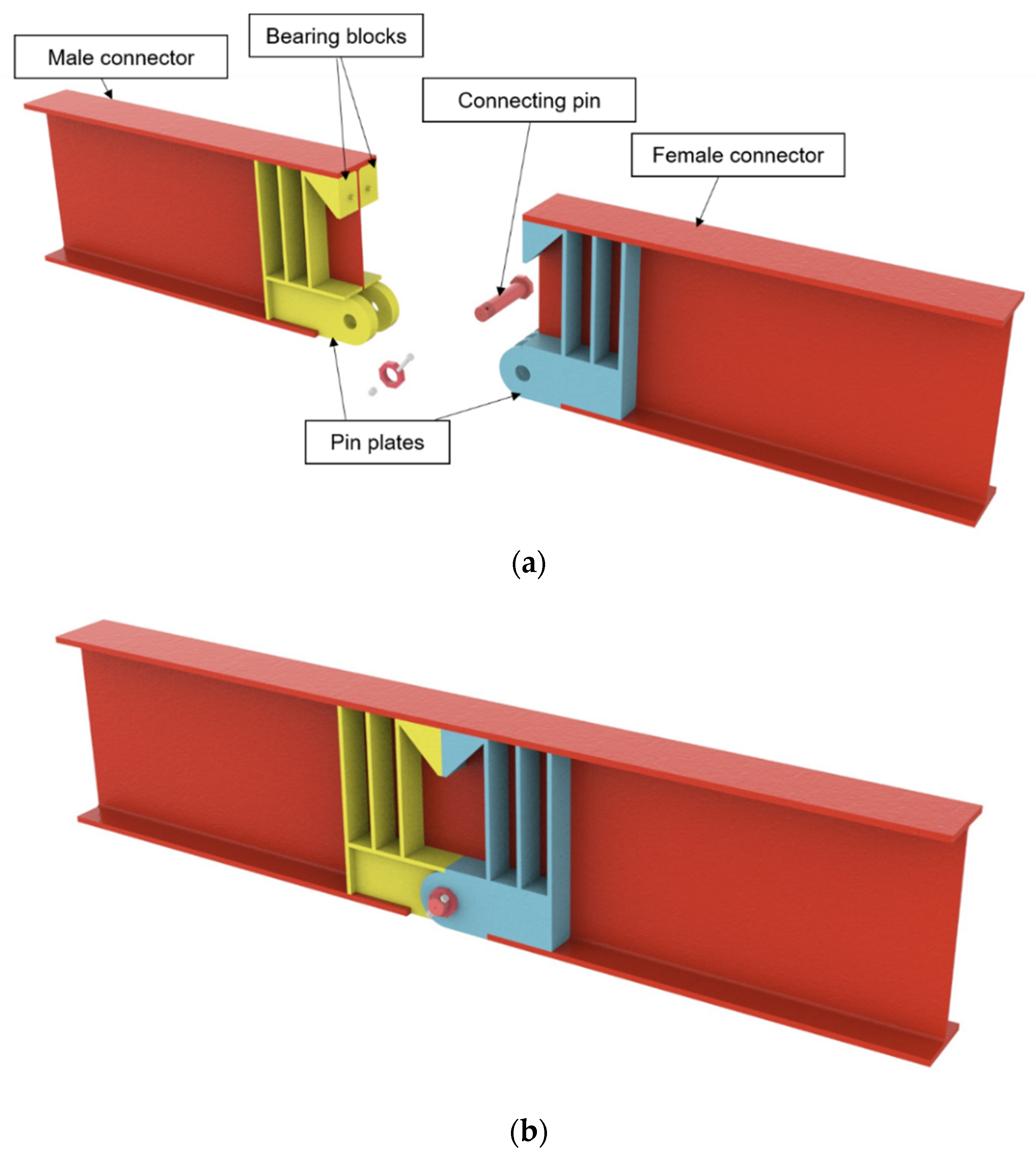
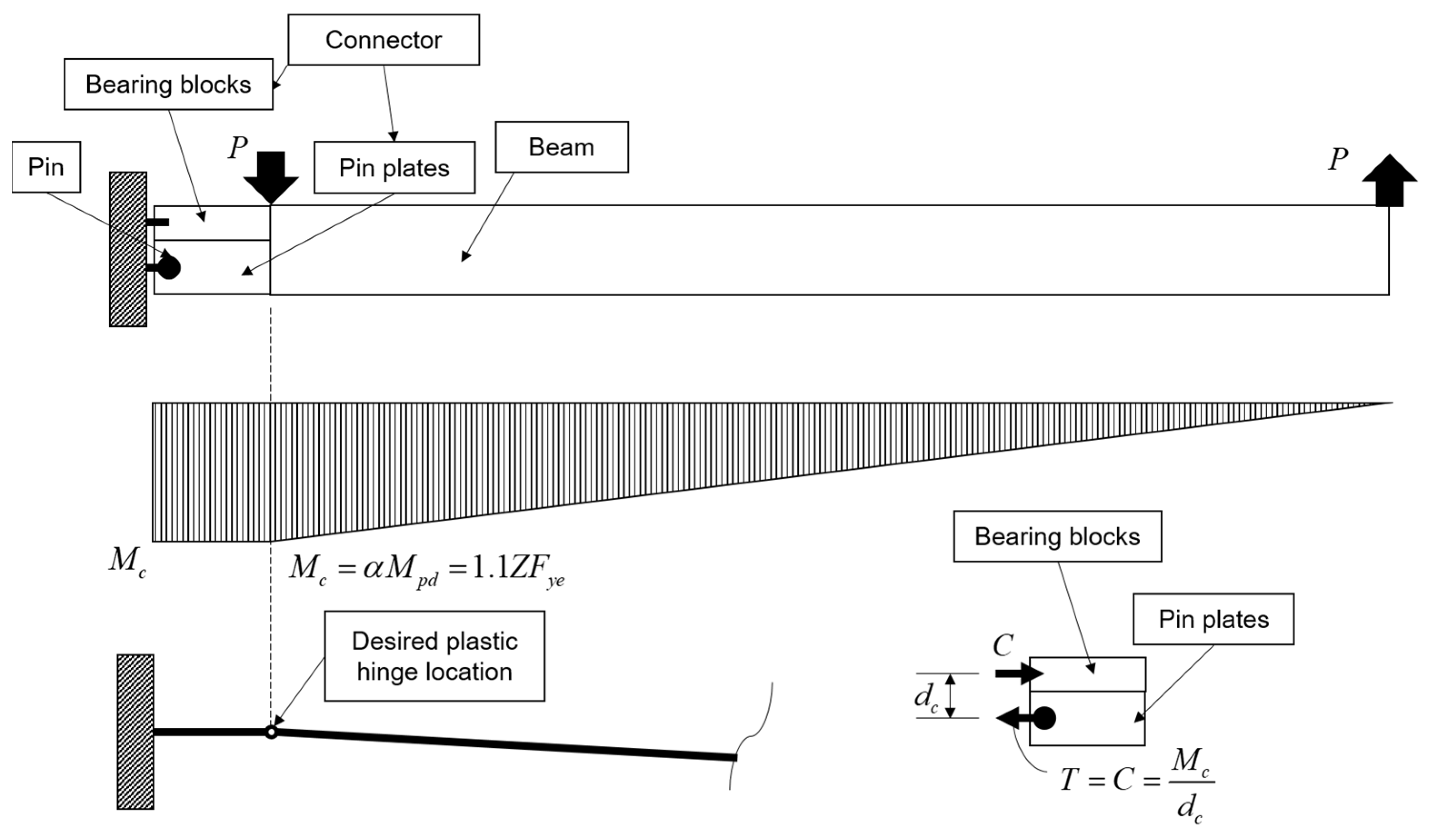
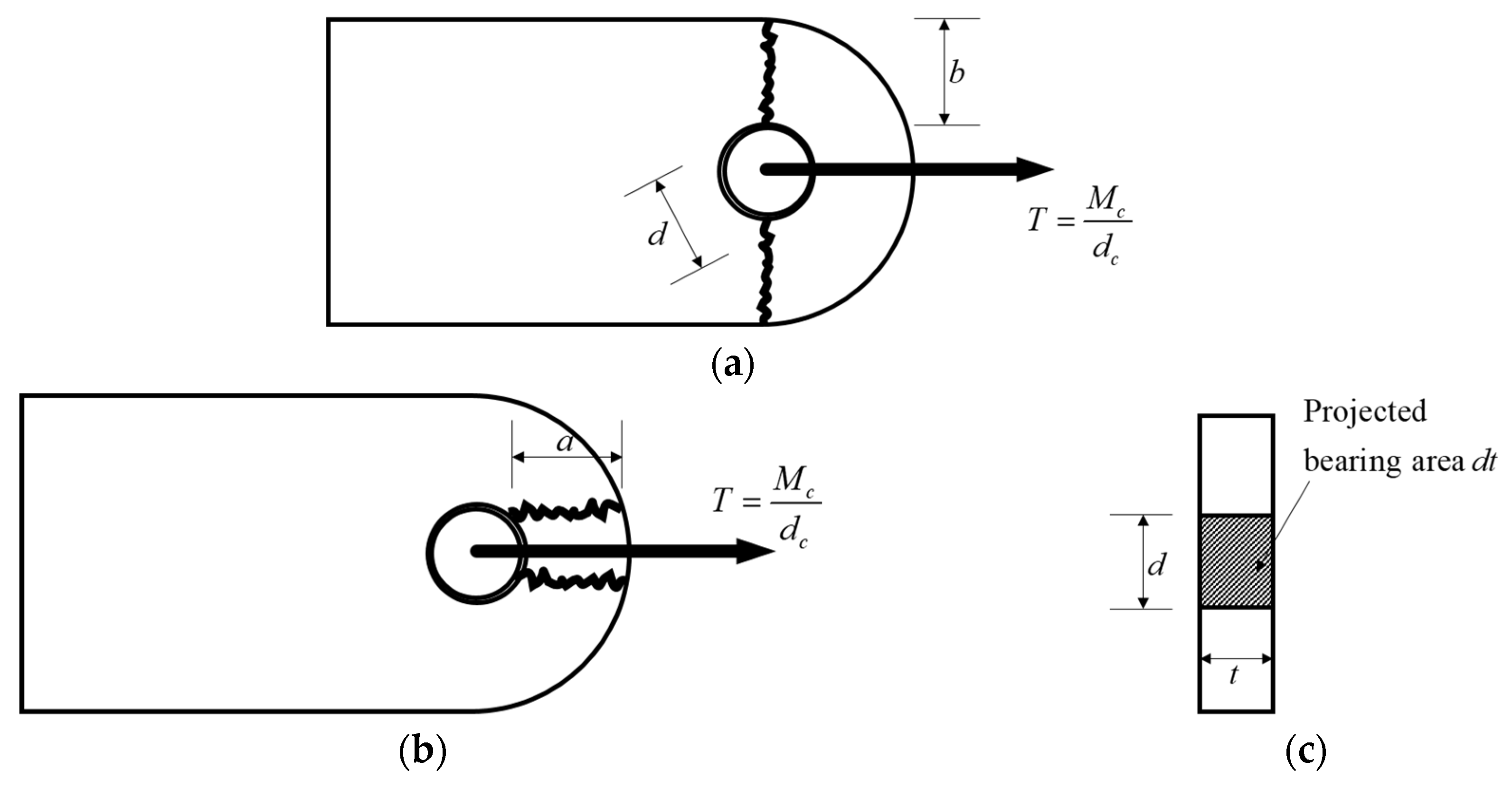

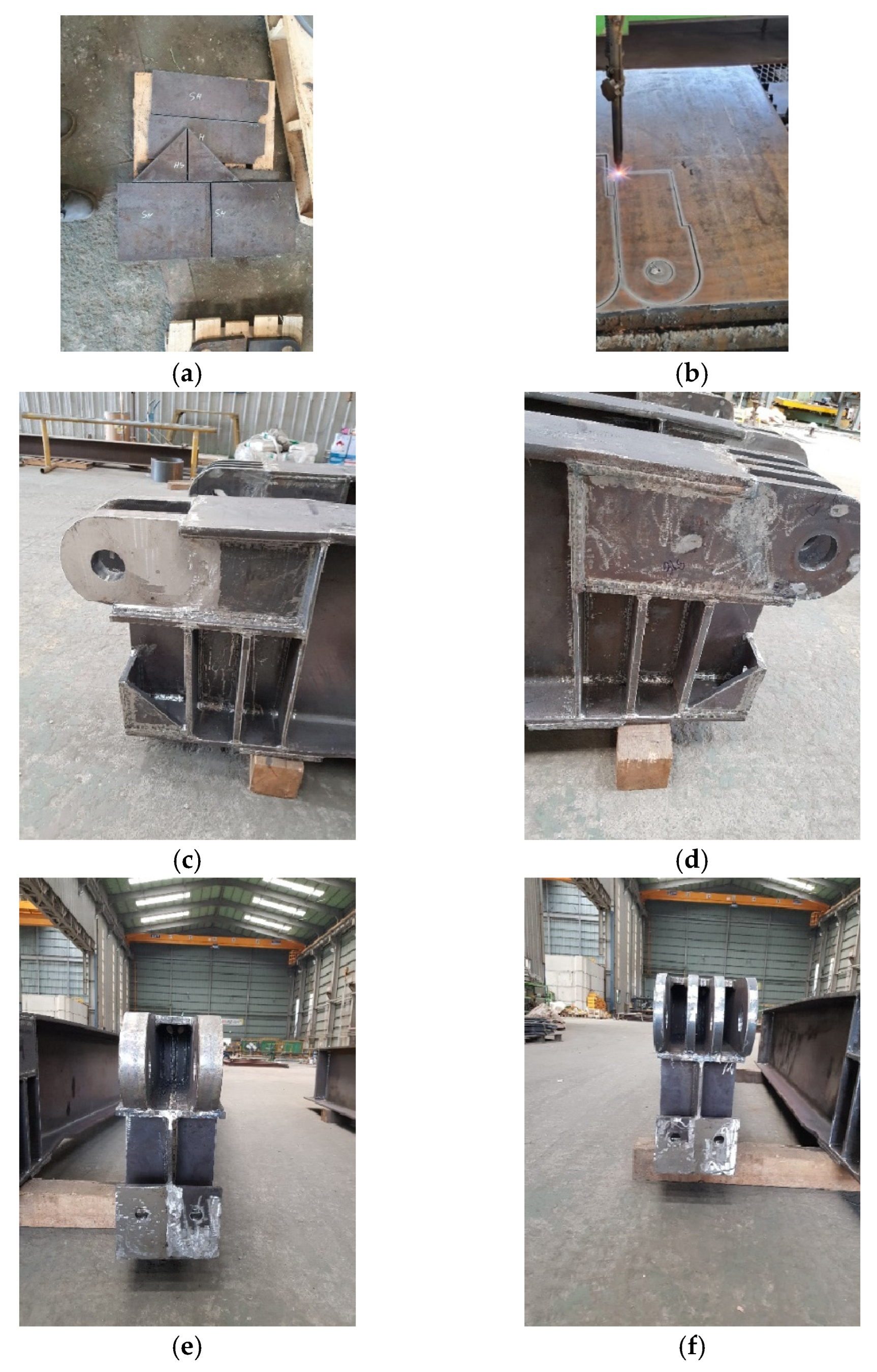



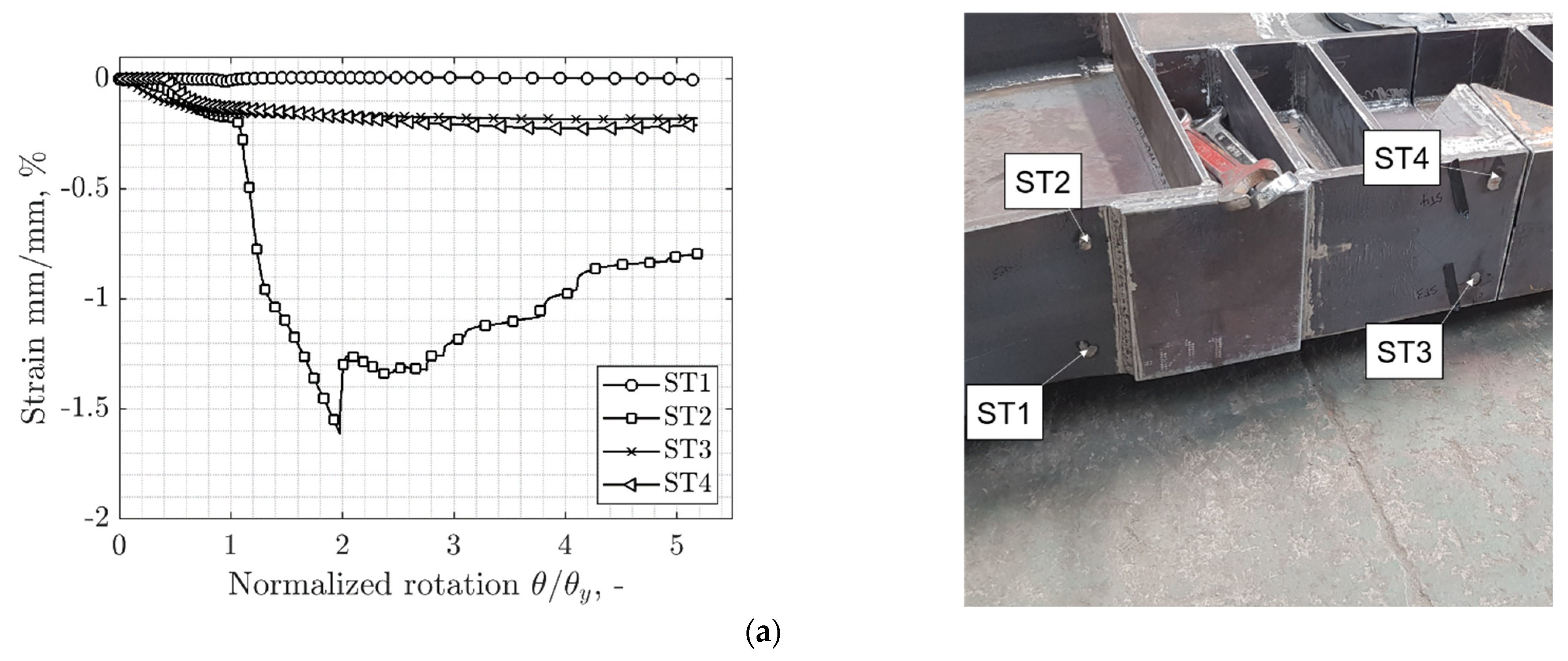
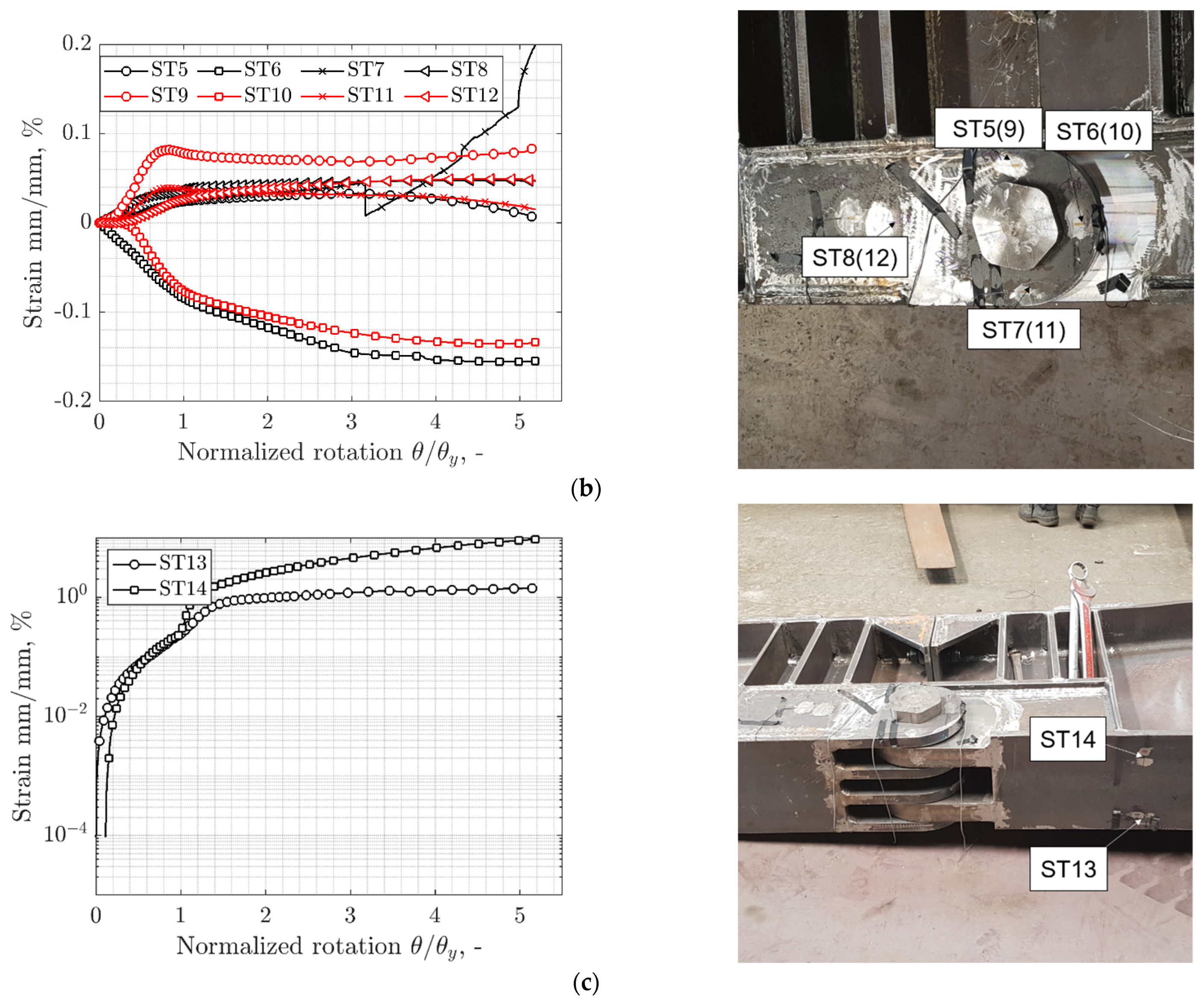
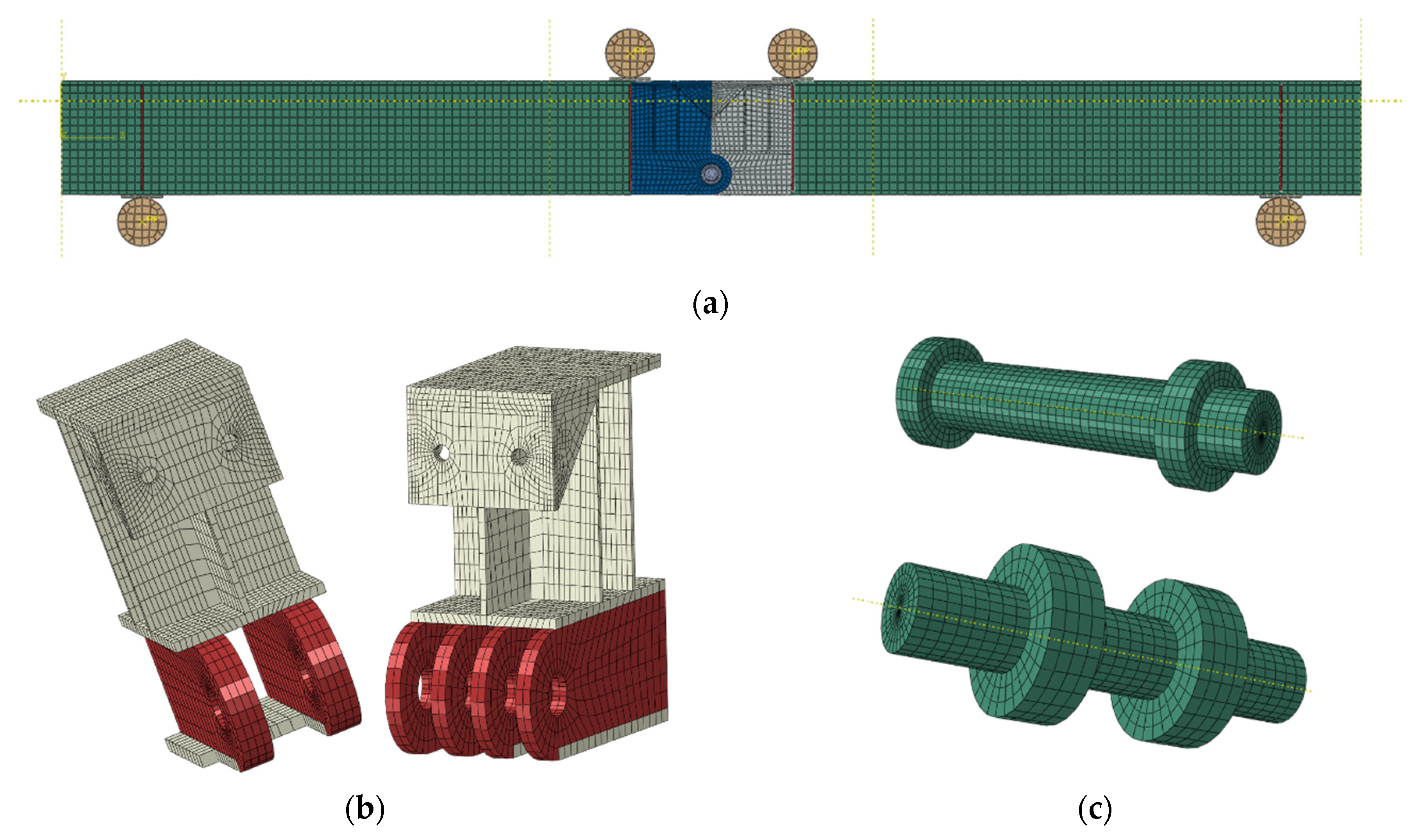
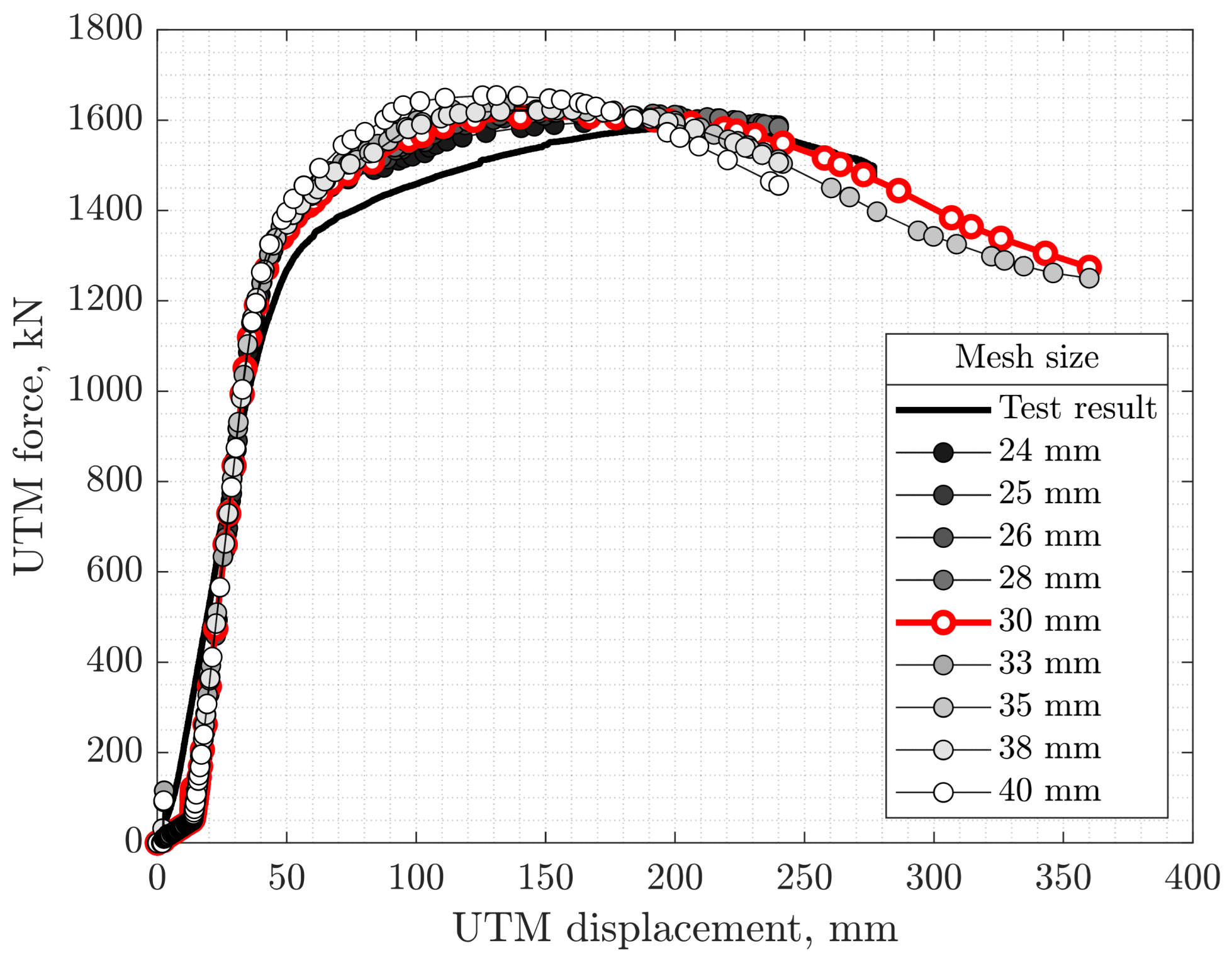
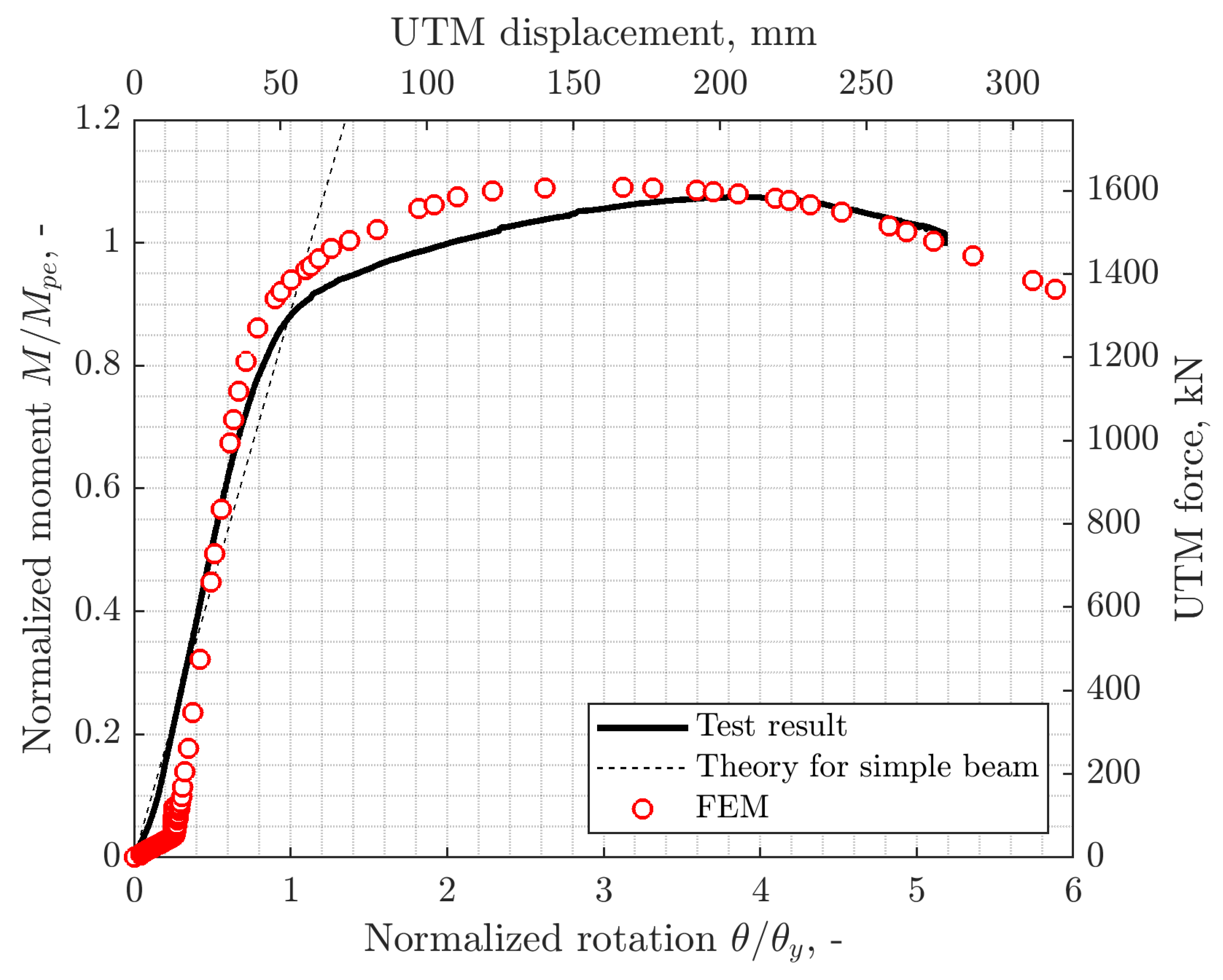
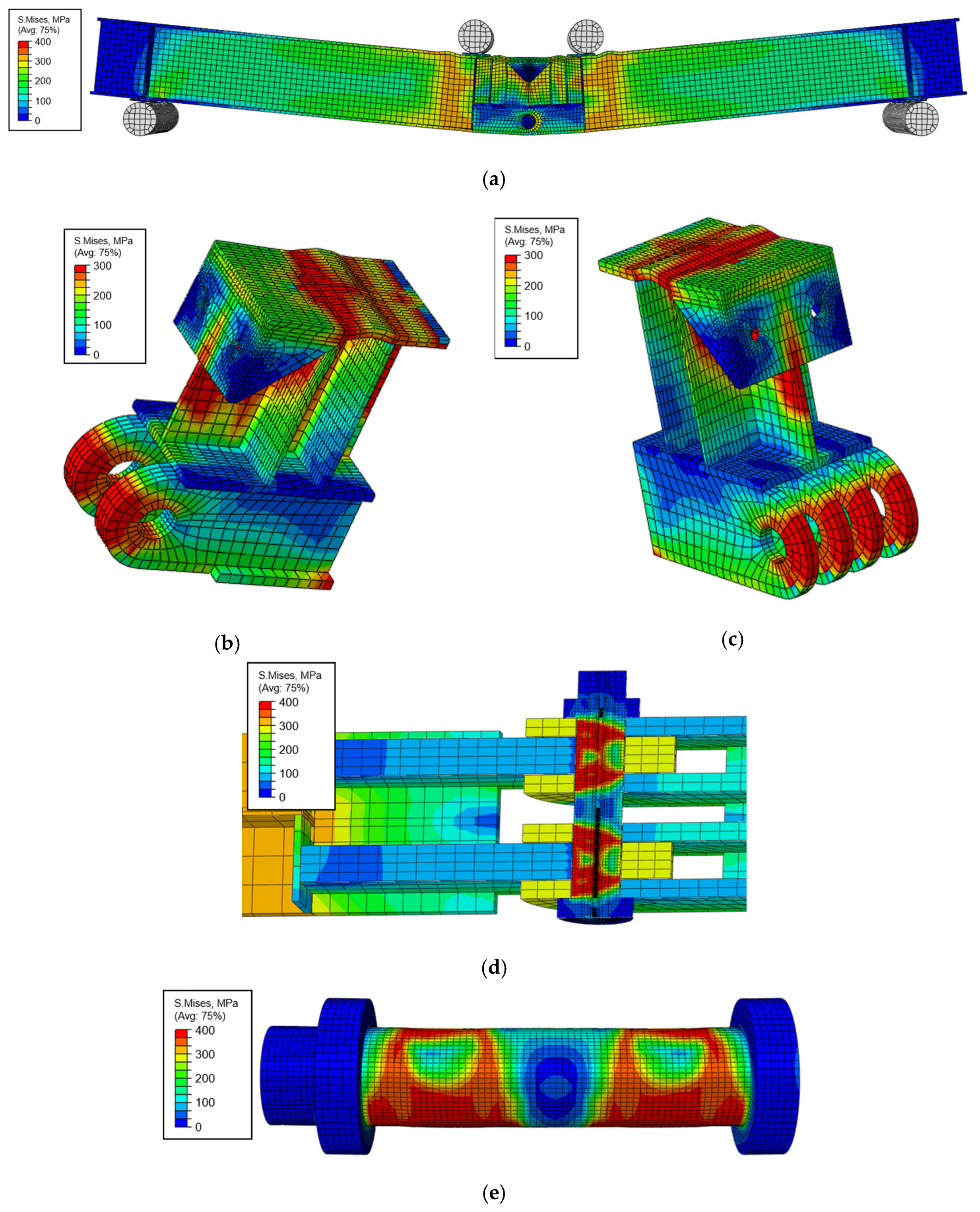
| Element | Grade | , MPa | , MPa | Elongation % |
|---|---|---|---|---|
| Beam(1) | SS275 | 347 | 501 | 20.0 |
| Beam(2) | SS275 | 350 | 498 | 29.4 |
| Beam(3) | SS275 | 356 | 501 | 29.5 |
| Beam(4) | SS275 | 344 | 497 | 30.2 |
| Plate-12T(1) | SS275 | 347 | 457 | 32.0 |
| Plate-12T(2) | SS275 | 364 | 472 | 31.0 |
| Plate-12T(3) | SS275 | 347 | 472 | 31.0 |
| Plate-20T(1) | SS275 | 306 | 452 | 31.0 |
| Plate-20T(2) | SS275 | 306 | 452 | 31.0 |
| Plate-20T(3) | SS275 | 298 | 455 | 32.0 |
| Plate-30T | SS275 | 304 | 482 | 32.0 |
| Plate-60T | SS275 | 322 | 452 | 36.0 |
| Elements | Failure Mode | Nominal Strength, kN | Design Strength, kN |
|---|---|---|---|
| Pin plates | Fracture of net section | 8561 | 6421 |
| Longitudinal shear rupture | 2391 | 1793 | |
| Bearing failure | 4752 | 3564 | |
| Yield of gross section | 14,850 | 13,365 | |
| Pin | Shear failure | 4224 | 3168 |
| Bearing failure | 6048 | 4536 |
Disclaimer/Publisher’s Note: The statements, opinions and data contained in all publications are solely those of the individual author(s) and contributor(s) and not of MDPI and/or the editor(s). MDPI and/or the editor(s) disclaim responsibility for any injury to people or property resulting from any ideas, methods, instructions or products referred to in the content. |
© 2024 by the authors. Licensee MDPI, Basel, Switzerland. This article is an open access article distributed under the terms and conditions of the Creative Commons Attribution (CC BY) license (https://creativecommons.org/licenses/by/4.0/).
Share and Cite
Jang, H.-L.; Han, C.-H.; Kim, R.-H.; Park, D.-Y.; Kim, S.-Y. Experimental and Numerical Analysis of a Temporary Bridge Connector Consisting of an Upper Bearing Block–Lower Pin Configuration. Appl. Sci. 2024, 14, 2012. https://doi.org/10.3390/app14052012
Jang H-L, Han C-H, Kim R-H, Park D-Y, Kim S-Y. Experimental and Numerical Analysis of a Temporary Bridge Connector Consisting of an Upper Bearing Block–Lower Pin Configuration. Applied Sciences. 2024; 14(5):2012. https://doi.org/10.3390/app14052012
Chicago/Turabian StyleJang, Hong-Lae, Chae-Hee Han, Ri-Ha Kim, Dae-Youl Park, and Sung-Yong Kim. 2024. "Experimental and Numerical Analysis of a Temporary Bridge Connector Consisting of an Upper Bearing Block–Lower Pin Configuration" Applied Sciences 14, no. 5: 2012. https://doi.org/10.3390/app14052012






